April 2016 Newsletter: Variations in the Annual Abundance of Sargassum
In the last newsletter we looked at the importance of Sargassum in catching dolphinfish, using the tagging records reported by recreational anglers. Anglers reported catching more than 66 percent of all fish tagged from 2006 through 2015 in association with Sargassum, showing the strong affinity dolphin have for the oceanic algae. Data from the different regions showed variations in the importance of Sargassum to catching dolphin. Now we will look at the fluctuations in the abundance of Sargassum from year to year.
Three main supply lines bring Sargassum to the U.S. Atlantic coast: the Loop Current from the Gulf of Mexico, the Old Bahamas Channel between the Bahamas Bank and the northern Caribbean Islands, and the Antilles Current that flows northward along the eastern side of the Bahamas and joins the Gulf Stream Current east of Fort Pierce, Florida. The grass that comes out of the Caribbean and through the Gulf of Mexico is the primary supply line for the Florida Keys. The algae coming out of the Old Bahamas Channel supplement those coming from the Gulf but most likely remain out of reach of most U.S. boats until reaching Key Largo, Florida. Anglers from Miami, Florida, northward are the primary beneficiaries of the second source of Sargassum and the dolphin that it brings with it. While the Antilles Current may intersect the Gulf Stream east of Fort Pierce, the benefits it brings are most likely first enjoyed by anglers off Cape Canaveral, Florida. It is the Antilles Current that most likely resupplies the Gulf Stream with big dolphin for the Carolinas, replacing the fish removed by the heavy fishing pressure that occurs off Florida east coast.
The frequency with which dolphin were caught around Sargassum from year to year could be an indirect measure of the relative abundance of Sargassum annually. To use the tagging data to gauge the macroalgae abundance, we need to accept the premise that, given the opportunity, dolphin will associate with Sargassum, and with more of the floating algae available there would be an increase in the percent of capture locations where the weed was present. To examine this hypothesis, the tagging activity in zone 2, the Straits of Florida, was chosen because more fish were tagged in this region (5,757) than any other region, and it had one of the highest numbers of tagging days (560) of any region. It also is at the origin of a major source of Sargassum for the East Coast, the Loop Current exit from the Gulf of Mexico.
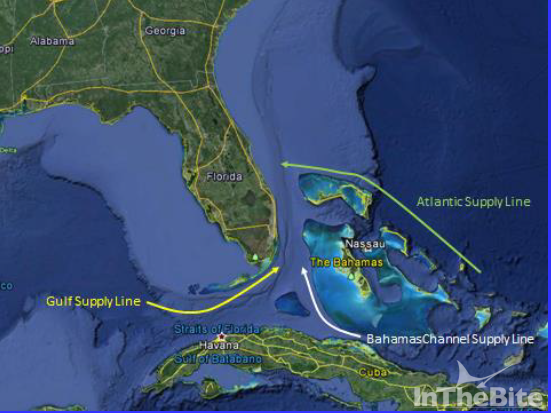 For our purpose capture locations were defined as any unique date-specific location where a dolphin was captured for tagging. This did not take into account whether a single boat captured fish at multiple locations on a single day or whether a different vessel was involved with every capture site on a specific day. The number of fish captured at any one location was not a consideration in determining Sargassum abundance, but it is used to characterize the dolphin affinity for Sargassum.
One of the most notable features about the ocean current flowing through the Florida Straits northward to Fort Pierce, Florida, is that it is basically confined in a ditch, roughly 50 miles wide created by the U.S. continental shelf and the Bahamas Bank. This feature acts to increase the concentration of Sargassum into well-formed lines and mats by reducing the area that the grass has to spread out over. This should increase the likelihood that fishermen would be able to find grass lines if they are present.
The number of days when fish were tagged each year (days sampled) varied from a low of 38 in 2007 to a high of 72 in 2015; see following figure. Over the ten-year period, 90 percent of the days sampled occurred from April through August. This sets the time period that this Sargassum abundance assessment applies. The number of sampling days (days when fish were tagged) averaged 55 days per year over the course of this study. The linear trend line in the figure shows the average annual sampling rose from 50 days in the beginning to 60 days by the end.
For our purpose capture locations were defined as any unique date-specific location where a dolphin was captured for tagging. This did not take into account whether a single boat captured fish at multiple locations on a single day or whether a different vessel was involved with every capture site on a specific day. The number of fish captured at any one location was not a consideration in determining Sargassum abundance, but it is used to characterize the dolphin affinity for Sargassum.
One of the most notable features about the ocean current flowing through the Florida Straits northward to Fort Pierce, Florida, is that it is basically confined in a ditch, roughly 50 miles wide created by the U.S. continental shelf and the Bahamas Bank. This feature acts to increase the concentration of Sargassum into well-formed lines and mats by reducing the area that the grass has to spread out over. This should increase the likelihood that fishermen would be able to find grass lines if they are present.
The number of days when fish were tagged each year (days sampled) varied from a low of 38 in 2007 to a high of 72 in 2015; see following figure. Over the ten-year period, 90 percent of the days sampled occurred from April through August. This sets the time period that this Sargassum abundance assessment applies. The number of sampling days (days when fish were tagged) averaged 55 days per year over the course of this study. The linear trend line in the figure shows the average annual sampling rose from 50 days in the beginning to 60 days by the end.
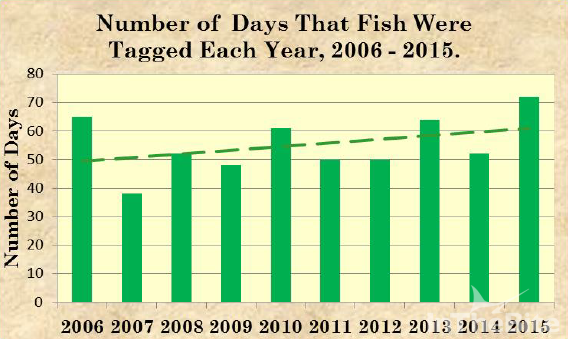 On each sampling day there were from one to ten capture locations recorded. A combined total of 1,359 catch locations, were noted during the study period off the Florida Keys. The following figure tracks the prevalence of Sargassum catch sites over the years. It shows a gradual decline in the grass sites in 2008 and 2009, an average of 74.6 percent of the locations, from the previous two years which averaged 80.1 percent. This was followed by a precipitous decline in 2010, where Sargassum catch sites reached an all-time low of 50.6 percent of the recorded locations. The oceanic algae quickly rebounded, accounting for 84.6 percent of the catch sites in 2011 and 2012. Fishermen noted a drop in catch sites with grass in 2013, when 76 percent of the locations were noted having grass. The most recent years of 2014 and 2015, saw some of the highest incidences of catch sites having macroalgae recorded, averaging 86 percent of the catch locations.
Over the duration of the study, catch locations where Sargassum was present accounted for 77.9 percent of all catch sites off the Keys. The trend line in the following figure indicates that the incidence of dolphin being caught in association with Sargassum was on the rise during the study period, increasing roughly 10 percent.
This data suggests that abundance of Sargassum in the Straits of Florida has been on the increase since its lowest point in 2010. This follows along with the reports of massive amounts of Sargassum invading the Caribbean in 2011, 2014 and 2015. Unfortunately, no reports are known that documented years with exceptionally low levels of Sargassum entering the Caribbean.
From the fishermen perspective, the important question is whether increased amounts of this lure-grabbing weed will bring more dolphin with it. The answer seems to be not necessarily. The following figure shows the estimated annual recreational harvest of dolphinfish from the east coast of Florida as reported by NOAA Fisheries from 2006 through 2015. While the low point in catch locations with Sargassum in 2010 does coincide with the lowest harvest level of dolphin according to NOAA Fisheries, this is where similarities end. According to the NOAA data from 2006 through 2010, east coast Florida anglers averaged harvesting 448,499 fish annually. The harvest dropped to an annual average of 382,861 fish from 2011 through 2015. This is a 15 percent decline in fish harvested during the same period that saw an 11 percent increase in catch locations associated with Sargassum.
On each sampling day there were from one to ten capture locations recorded. A combined total of 1,359 catch locations, were noted during the study period off the Florida Keys. The following figure tracks the prevalence of Sargassum catch sites over the years. It shows a gradual decline in the grass sites in 2008 and 2009, an average of 74.6 percent of the locations, from the previous two years which averaged 80.1 percent. This was followed by a precipitous decline in 2010, where Sargassum catch sites reached an all-time low of 50.6 percent of the recorded locations. The oceanic algae quickly rebounded, accounting for 84.6 percent of the catch sites in 2011 and 2012. Fishermen noted a drop in catch sites with grass in 2013, when 76 percent of the locations were noted having grass. The most recent years of 2014 and 2015, saw some of the highest incidences of catch sites having macroalgae recorded, averaging 86 percent of the catch locations.
Over the duration of the study, catch locations where Sargassum was present accounted for 77.9 percent of all catch sites off the Keys. The trend line in the following figure indicates that the incidence of dolphin being caught in association with Sargassum was on the rise during the study period, increasing roughly 10 percent.
This data suggests that abundance of Sargassum in the Straits of Florida has been on the increase since its lowest point in 2010. This follows along with the reports of massive amounts of Sargassum invading the Caribbean in 2011, 2014 and 2015. Unfortunately, no reports are known that documented years with exceptionally low levels of Sargassum entering the Caribbean.
From the fishermen perspective, the important question is whether increased amounts of this lure-grabbing weed will bring more dolphin with it. The answer seems to be not necessarily. The following figure shows the estimated annual recreational harvest of dolphinfish from the east coast of Florida as reported by NOAA Fisheries from 2006 through 2015. While the low point in catch locations with Sargassum in 2010 does coincide with the lowest harvest level of dolphin according to NOAA Fisheries, this is where similarities end. According to the NOAA data from 2006 through 2010, east coast Florida anglers averaged harvesting 448,499 fish annually. The harvest dropped to an annual average of 382,861 fish from 2011 through 2015. This is a 15 percent decline in fish harvested during the same period that saw an 11 percent increase in catch locations associated with Sargassum.
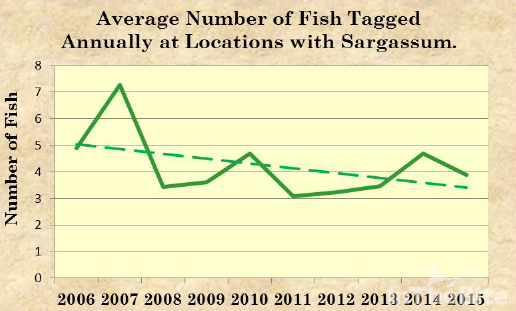 Unfortunately, the tagging data show similarities with the NOAA harvest data, when you look at the average number of fish tagged annually at locations in the Straits of Florida where Sargassum was present. See the following figure. While there are several small differences, such as the fewest fish tagged per site occurred in 2011 and the largest number tagged per site was in 2007, the major point is shown by the linear trend line that shows a steady decline over time in the number of fish captured per site having Sargassum.
Information from the tagging of dolphin does appear to indicate an annual fluctuation in the abundance of Sargassum in the Florida Straits. The years where there was an increase in the frequency of catch locations associated with Sargassum did not match up with years that NOAA data noted increased harvests of dolphin. Additionally, examining the yearly average number of dolphin tagged per catch site with Sargassum shows a steady decline over time similar to that shown by NOAA data for the harvest of dolphinfish. These latter two indicators suggest a decrease in the abundance of fish, during years with an increased abundance of Sargassum.
In case you are wondering whether more fish are tagged in years when more fish were harvested as indicated by the NOAA report, the answer is yes and no. There must be enough fish present for anglers to catch enough to satisfy their freezer needs, but after that point the decision to tag is a matter of personal whim. We know that the peak in tagging activity follows the actual peak in fish abundance. When you compare the annual tagging activity in the Florida Keys (see figure below) to the NOAA figure of dolphin harvested or the figure of the annual number of fish tagged per Sargassum catch location, there is little to no correlation. In the end, the decision to tag is largely independent of fish abundance, and more related to the individual dedication to conservation.
Unfortunately, the tagging data show similarities with the NOAA harvest data, when you look at the average number of fish tagged annually at locations in the Straits of Florida where Sargassum was present. See the following figure. While there are several small differences, such as the fewest fish tagged per site occurred in 2011 and the largest number tagged per site was in 2007, the major point is shown by the linear trend line that shows a steady decline over time in the number of fish captured per site having Sargassum.
Information from the tagging of dolphin does appear to indicate an annual fluctuation in the abundance of Sargassum in the Florida Straits. The years where there was an increase in the frequency of catch locations associated with Sargassum did not match up with years that NOAA data noted increased harvests of dolphin. Additionally, examining the yearly average number of dolphin tagged per catch site with Sargassum shows a steady decline over time similar to that shown by NOAA data for the harvest of dolphinfish. These latter two indicators suggest a decrease in the abundance of fish, during years with an increased abundance of Sargassum.
In case you are wondering whether more fish are tagged in years when more fish were harvested as indicated by the NOAA report, the answer is yes and no. There must be enough fish present for anglers to catch enough to satisfy their freezer needs, but after that point the decision to tag is a matter of personal whim. We know that the peak in tagging activity follows the actual peak in fish abundance. When you compare the annual tagging activity in the Florida Keys (see figure below) to the NOAA figure of dolphin harvested or the figure of the annual number of fish tagged per Sargassum catch location, there is little to no correlation. In the end, the decision to tag is largely independent of fish abundance, and more related to the individual dedication to conservation.
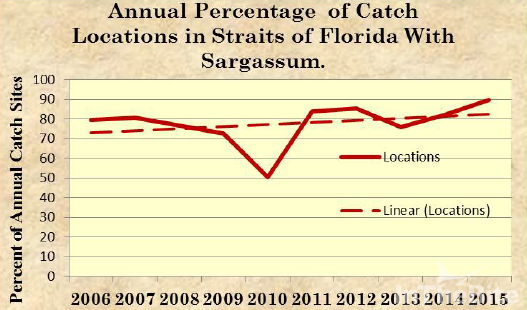 While having more Sargassum offshore may not bring more dolphin, it will certainly increase the odds of finding fish. It will also provide more nursery habitat for larval and juvenile dolphin to hide from predators. This should help to increase their survival rate, ensuring a healthy population of dolphin for next year fishing.
While having more Sargassum offshore may not bring more dolphin, it will certainly increase the odds of finding fish. It will also provide more nursery habitat for larval and juvenile dolphin to hide from predators. This should help to increase their survival rate, ensuring a healthy population of dolphin for next year fishing.
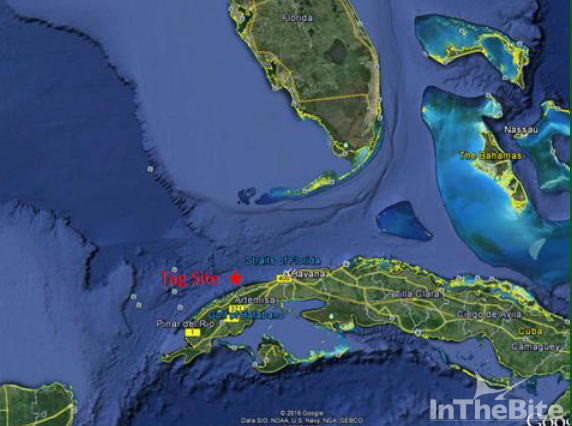 On February 28, 2016 the first dolphin tagged for the Dolphinfish Research Program in Cuban waters were released off La Boca, Cuba. Fishing about 30 miles west of Havana and 1.5 miles off the beach, the crew of the Mt. Pleasant, South Carolina, boat Jabez, owned by Carl Ulm tagged two of the six dolphin they caught that day.
They were able to fish four days during their visit to Cuba, with their best day being one where they received a permit to fish in a restricted area, where they caught eight wahoo and numerous bonitos. Capt. Ben Polk reported that they passed numerous longlines every day and saw men in 12-foot long rowboats fishing in 2,000 feet of water. There was even one man fishing from a sheet of Styrofoam.
We know that Cuba and the U.S. share the same stock of dolphin because of three earlier tag recoveries of dolphin released off the U.S. East Coast. The DRP needs dolphin tagged along the entire northshore of Cuba to learn their dispersal patterns from these previously forbidden waters. Since most Cuban fishermen are subsistence fishermen, the tagging will have to be done by U.S. anglers visiting our neighbor to the south.
For More Information, Contact
Don Hammond
Dolphinfish Research Program
Cooperative Science Services, LLC
961 Anchor Rd., Charleston, SC 29412
Telephone FAX (843) 795-7524
Email [email protected]
Web site www.dolphintagging.com
On February 28, 2016 the first dolphin tagged for the Dolphinfish Research Program in Cuban waters were released off La Boca, Cuba. Fishing about 30 miles west of Havana and 1.5 miles off the beach, the crew of the Mt. Pleasant, South Carolina, boat Jabez, owned by Carl Ulm tagged two of the six dolphin they caught that day.
They were able to fish four days during their visit to Cuba, with their best day being one where they received a permit to fish in a restricted area, where they caught eight wahoo and numerous bonitos. Capt. Ben Polk reported that they passed numerous longlines every day and saw men in 12-foot long rowboats fishing in 2,000 feet of water. There was even one man fishing from a sheet of Styrofoam.
We know that Cuba and the U.S. share the same stock of dolphin because of three earlier tag recoveries of dolphin released off the U.S. East Coast. The DRP needs dolphin tagged along the entire northshore of Cuba to learn their dispersal patterns from these previously forbidden waters. Since most Cuban fishermen are subsistence fishermen, the tagging will have to be done by U.S. anglers visiting our neighbor to the south.
For More Information, Contact
Don Hammond
Dolphinfish Research Program
Cooperative Science Services, LLC
961 Anchor Rd., Charleston, SC 29412
Telephone FAX (843) 795-7524
Email [email protected]
Web site www.dolphintagging.com











